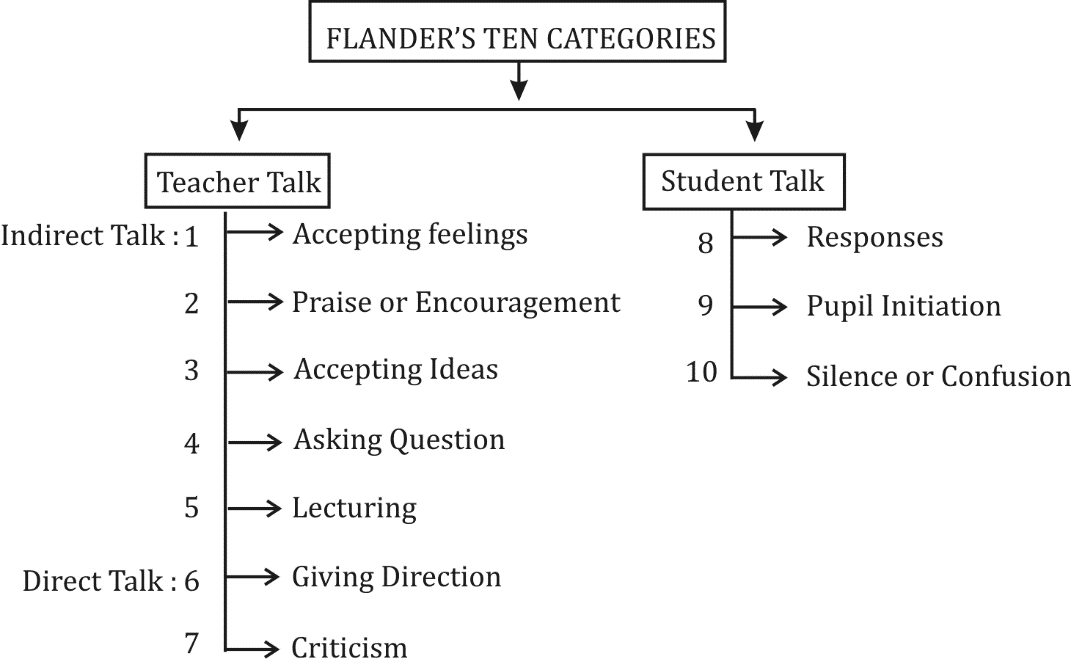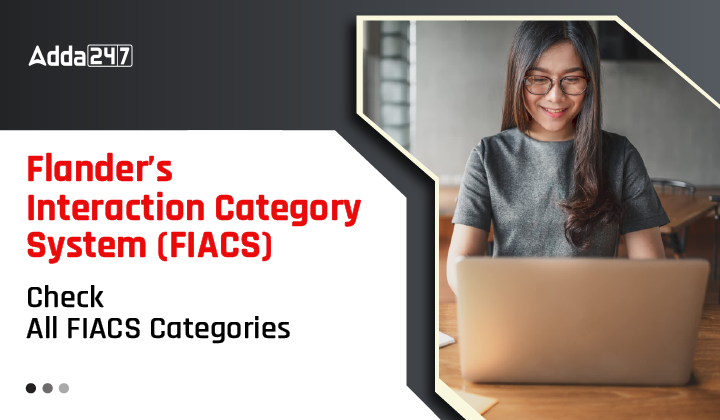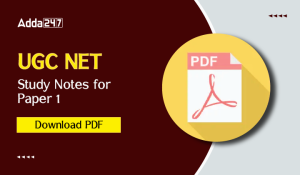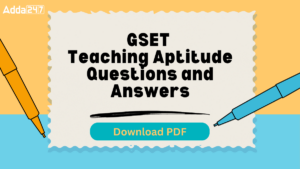Table of Contents
Flanders developed a system of interaction analysis to study what is happening in a classroom when a teacher teaches. In Flander’s Interaction Category System, the teacher influences the students; students also interact with the teacher. Flanders classified total verbal behaviour into 10 categories which makes teaching more fun and joyful. Download PDF in Hindi English for Flander System Child Development and Pedagogy (CDP) study notes for teaching exams i.e. UGC NET, CTET, HTET, KVS and others. Here, to make this more helpful we are providing you category-wise Flander’s Interaction Category System.
Flander’s Interaction Category System
Flander thought of this method in 1959 this method was formulated for teacher effectiveness and student welfare. This method is used especially for verbal behaviour and class communication. The communication between the student and the teacher is generally verbal rather than non-verbal. Flander’s believed that the verbal behaviour of the class reflects upon the general class behaviour. Verbal behaviour can be analysed with great faithfulness.
फ़्लैंडर की बातचीत की श्रेणी व्यवस्था
1959 में फ़्लैंडर ने इस विधि के बारे में सोचा और इस पद्धति को शिक्षक प्रभावशीलता और छात्र कल्याण के लिए तैयार किया गया। इस पद्धति का उपयोग विशेष रूप से मौखिक व्यवहार और कक्षा संचार के लिए किया जाता है। छात्र और शिक्षक के बीच संचार गैर-मौखिक के बजाय आमतौर पर मौखिक होता है। फ्लैंडर का मानना था कि कक्षा का मौखिक व्यवहार सामान्य वर्ग के व्यवहार को दर्शाता है। मौखिक व्यवहार का विश्लेषण बड़ी ईमानदारी के साथ किया जा सकता है।
With this method, any activity that takes place in 3 seconds or even less can be systematically analysed. This is a factual and scientific method of analysis. The main importance of this method is the initiation and response between two or more individuals.
इस पद्धति के साथ, 3 सेकंड या उससे भी कम समय में होने वाली किसी भी गतिविधि का व्यवस्थित विश्लेषण किया जा सकता है। यह विश्लेषण का एक तथ्यात्मक और वैज्ञानिक तरीका है। इस पद्धति का मुख्य महत्व दो या अधिक व्यक्तियों के बीच प्रारम्भ और प्रतिक्रिया है
Various Categories विभिन्न श्रेणियां
Flanders has divided the class behaviour between the students and teacher into ten categories. The division is as follows
(a) Teacher talk – 7 Categories
(b) Student talk -2 Categories
(c) Silence or confusion -1 Category
फ्लैंडर्स ने छात्रों और शिक्षक के बीच कक्षा व्यवहार को दस श्रेणियों में विभाजित किया है। विभाजन इस प्रकार है
(a) शिक्षक बातचीत – 7 श्रेणियां
(b) छात्र बातचीत -2 श्रेणियां
(c) मौन या भ्रम -1 श्रेणी
First seven categories have also been divided into two parts. The first part is Direct Talk and the other is Indirect Talk.
पहली सात श्रेणियों को भी दो भागों में विभाजित किया गया है। पहला हिस्सा प्रत्यक्ष बातचीत और दूसरा अप्रत्यक्ष बातचीत है

Meaning of Various Categories विभिन्न श्रेणियों के अर्थ
(a) Indirect Influence -The teacher affects the students indirectly in this method in the following first four categories
अप्रत्यक्ष प्रभाव – शिक्षक पहली चार श्रेणियों में इस पद्धति से अप्रत्यक्ष रूप से छात्रों को प्रभावित करता है।
Category 1: Accepting Feelings – In this category, the teacher accepts the feelings of the students. In this category the students have the right to demonstrate their feelings
श्रेणी- 1: भावनाओं को स्वीकार करना – इस श्रेणी में, शिक्षक छात्रों की भावनाओं को स्वीकार करता है। इस श्रेणी में छात्रों को अपनी भावनाओं को प्रदर्शित करने का अधिकार है.
Category 2: Praise or Encouragement – The teacher praises the activities of the students saying “good”, “excellent” and encourages them by promoting them to explain or to “say more”, “explain more”, “elaborate further” etc
श्रेणी 2: प्रशंसा या प्रोत्साहन देना – शिक्षक छात्रों की गतिविधियों को ‘अच्छा’, ‘उत्कृष्ट’ कहते हुए उनकी प्रशंसा करता है और उन्हें समझाने के लिए या “और अधिक कहने”, “अधिक समझाने”, “आगे विस्तृत करने” आदि को बढ़ावा देकर प्रोत्साहित करता है।
Category 3: Accepting or using Ideas – In this category the teacher accepts the ideas of the students. He explains their suggestions or ideas in his own words or style
श्रेणी 3: विचारों को स्वीकार करना या उपयोग करना – इस श्रेणी में शिक्षक छात्रों के विचारों को स्वीकार करता है। वह अपने सुझाव या विचार अपने शब्दों या शैली में समझाता है
Category 4: Asking Questions – This category includes only asking questions. After asking questions, the teacher should necessarily get the answers
श्रेणी 4: प्रश्न पूछना- इस श्रेणी में केवल प्रश्न पूछना शामिल है। प्रश्न पूछने के बाद, शिक्षक को आवश्यक रूप से उत्तर प्राप्त करने चाहिए
(b) Direct Influence or Direct Teacher Behaviour प्रत्यक्ष प्रभाव या प्रत्यक्ष शिक्षक व्यवहार
Category 5: Lecture – This is a kind of verbal interaction, and this category is used for giving information or for apprising someone of some opinions or when the teacher is trying to explain something, or is discussing something
श्रेणी 5: व्याख्यान – यह एक प्रकार की मौखिक बातचीत है, और इस श्रेणी का उपयोग किसी को कुछ राय देने के लिए या जब शिक्षक कुछ समझाने की कोशिश कर रहा होता है, या किसी चीज़ के बारे में चर्चा करने के लिए किया जाता है।
Category 6: Giving Directions – Instructing the children to do something in the class is called giving directions like “all students will stand in front” or “sit down and do the work.”
श्रेणी 6: दिशा-निर्देश देना – बच्चों को कक्षा में कुछ करने के लिए निर्देश देना जैसे “सभी छात्र सामने खड़े होंगे” या “बैठो और काम करो” जैसे निर्देश देता है।
Category 7 : Criticizing and Justifying Authority – This is used, when the teacher criticizes a students for his improper behaviour, and says, “I don’t like this” or “I will turn you out of the class”, “Be silent”, “Get out” etc.
श्रेणी 7 : आलोचना और औचित्य प्राधिकरण – यह तब उपयोग किया जाता है, जब शिक्षक अनुचित व्यवहार के लिए छात्रों की आलोचना करता है, और कहता है, “मुझे यह पसंद नहीं है” या “मैं आपको कक्षा से बाहर कर दूंगा”, “चुप रहो”, “जाओ बाहर” आदि।
(c) Pupil Talk – This has been sub divided into two groups. The first student Talk Response and the other is pupil Talk conversation.
छात्र बातचीत- इसे दो समूहों में विभाजित किया गया है। पहली छात्र बातचीत है प्रतिक्रिया और दूसरी छात्र बातचीत वार्तालाप है
Category 8: Pupil Talk Responses – When the teacher asks questions from the students, then the students answer the questions and obey the instructions in a verbal manner, then all these responses come in this kind of category.
श्रेणी 8: छात्र बातचीत की प्रतिक्रियाएँ- जब शिक्षक छात्रों से सवाल पूछता है, तो छात्र सवालों के जवाब देते हैं और मौखिक तरीके से निर्देशों का पालन करते हैं, फिर ये सभी प्रतिक्रियाएं इस तरह की श्रेणी में आती हैं।
Category 9: Pupil Initiation– In this the students initiate the discussion, and are curious to ask questions and say something. This kind of response is included in this category. The expression of ideas by students is included in this category.
श्रेणी 9: छात्र प्रारंभ- इसमें छात्र चर्चा शुरू करते हैं, और प्रश्न पूछने और कुछ कहने के लिए उत्सुक होते हैं। इस श्रेणी में इस तरह की प्रतिक्रिया शामिल है। छात्रों द्वारा विचारों की अभिव्यक्ति को इस श्रेणी में शामिल किया गया है
Category 10 : Silence or Confusion – In the class the Student’s silence or confusion, comes under this category
श्रेणी 10 : मौन या भ्रम – कक्षा में छात्र की चुप्पी या भ्रम, इस श्रेणी में आता है।
Advantages of Flander’s Interaction Analysis फ़्लैंडर्स बातचीत विश्लेषण के लाभ
(1) Through this method, even without a sender, the information about interaction of the whole class can be got, with the help of Matrix.
इस पद्धति के माध्यम से, यहां तक कि एक प्रेषक के बिना, मैट्रिक्स की मदद से पूरी कक्षा की बातचीत के बारे में जानकारी प्राप्त की जा सकती है।
(2) This method provides proper feedback to the teachers and the pupil teachers.
यह विधि शिक्षकों और प्रशिक्षु शिक्षकों को उचित प्रतिक्रिया प्रदान करती है।
(3) This is an effective method to estimate the social and emotional atmosphere of the class.
यह कक्षा के सामाजिक और भावनात्मक वातावरण का अनुमान लगाने के लिए एक प्रभावी तरीका है।
(4) This is a useful method for in-service teachers also.
यह इन-सर्विस शिक्षकों के लिए भी एक उपयोगी तरीका है।
(5) Differences can be found on the basis of age, sex and subject matter by developing matrix.
मैट्रिक्स विकसित करके उम्र, लिंग और विषय के आधार पर अंतर पाया जा सकता है।
(6) This is a factual method of classroom teaching.
यह कक्षा शिक्षण का एक तथ्यात्मक तरीका है।
(7) In this method the teacher lays greater emphasis on discussion.
इस विधि में शिक्षक चर्चा पर अधिक जोर देता है।
(8) This is an analytical method to know about each activity of the class.
कक्षा की प्रत्येक गतिविधि के बारे में जानने के लिए यह एक विश्लेषणात्मक विधि है
Limitations of Flander’s Interaction Analysis / फ़्लैंडर्स बातचीत विश्लेषण की सीमाएं
(1) In this method full details of all the activities cannot be obtained and some behaviours cannot be categorized and go unobserved.
इस पद्धति में सभी गतिविधियों का पूरा विवरण प्राप्त नहीं किया जा सकता है और कुछ व्यवहारों को वर्गीकृत नहीं किया जा सकता है और उन्हें अप्रमाणित किया जा सकता है।
(2) This method is related to the social skills of organizing the class – arrangements etc.
यह विधि कक्षा व्यवस्था आदि के सामाजिक कौशल से संबंधित है।
(3) This is an expensive method, and it is not always possible to use it.
यह एक महंगी विधि है, और इसका उपयोग करना हमेशा संभव नहीं होता है।
(4) This is not a complete research method in itself.
यह अपने आप में पूर्ण शोध पद्धति नहीं है।
(5) Sometimes the class becomes monotonous, because figures and statistics have to be collected.
कभी-कभी कक्षा नीरस हो जाती है, क्योंकि इसमें आंकड़े एकत्र करने होते हैं।
(6) In this method, there are 7 categories of Teacher Talk and only 2 for student Talk. So very little attention is paid to student Talk.
इस पद्धति में, शिक्षक बातचीत की 7 श्रेणियां हैं और छात्र बातचीत के लिए केवल 2 हैं। इसलिए छात्र बातचीत पर बहुत कम ध्यान दिया जाता है।
(7) Training faithful teacher is also a problem. Due to lack of such teachers, this method cannot be used.
वफादार शिक्षक को प्रशिक्षित करना भी एक समस्या है। ऐसे शिक्षकों की कमी के कारण, इस पद्धति का उपयोग नहीं किया जा सकता है।
Flanders Interaction Category System (FIACS) PDF Notes
Candidates preparing for Teaching Exams can easily access the Flanders Interaction Category System (FIACS) Notes PDF file from the link provided below. They can refer to the PDF as a reference during preparation and most importantly during revisions.
Download Flander’s Interaction Category System Notes PDF




 UGC NET Study Notes for Paper 1, Downloa...
UGC NET Study Notes for Paper 1, Downloa...
 GSET Teaching Aptitude Questions and Ans...
GSET Teaching Aptitude Questions and Ans...
 समुद्र का पर्य�...
समुद्र का पर्य�...












